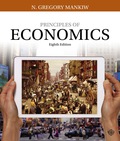
EBK PRINCIPLES OF ECONOMICS
8th Edition
ISBN: 8220103600453
Author: Mankiw
Publisher: CENGAGE L
expand_more
expand_more
format_list_bulleted
Question
Chapter 31, Problem 6PA
Sub part (a)
To determine
Influence on US real exchange rate in different situations.
Sub part (b)
To determine
Influence on US real exchange rate in different situations.
Sub part (c)
To determine
Influence on US real exchange rate in different situations.
Sub part (d)
To determine
Influence on US real exchange rate in different situations.
Expert Solution & Answer
Want to see the full answer?
Check out a sample textbook solution
Students have asked these similar questions
not use ai
Consider the following statements: a. Fewer people are employed in Freedonia now than at any time in the past 75 years. b. The unemployment rate in Freedonia is lower now than it has been in 75 years.Can both of these statements be true at the same time?
A. Yes, these statements can be correct if more people are classified as "discouraged workers."B. No, these statements cannot be true since unemployment must increase as employment decreases.C. Yes, if the number of unemployed decreases more than the number of employed.D. Yes, both of these statements can be correct if labor productivity increases.
Asap please and quality answer
Knowledge Booster
Similar questions
- 1) Use the supply and demand schedules to graph the supply and demand functions. Find and show on the graph the equilibrium price and quantity, label it (A). P Q demanded P Q supplied 0 75 0 0 5 65 5 0 10 55 10 0 15 45 15 10 20 35 20 20 25 25 25 30 30 15 30 40 35 40 5 0 35 40 50 60 2) Find graphically and numerically the consumers and producers' surplus 3) The government introduced a tax of 10$, Label the price buyers pay and suppliers receive. Label the new equilibrium for buyers (B) and Sellers (S). How the surpluses have changed? Give the numerical answer and show on the graph. 4) Calculate using midpoint method the elasticity of demand curve from point (A) to (B) and elasticity of the supply curve from point (A) to (C).arrow_forwardFour heirs (A, B, C, and D) must divide fairly an estate consisting of three items — a house, a cabin and a boat — using the method of sealed bids. The players' bids (in dollars) are: In the initial allocation, player D Group of answer choices gets no items and gets $62,500 from the estate. gets the house and pays the estate $122,500. gets the cabin and gets $7,500 from the estate. gets the boat and and gets $55,500 from the estate. none of thesearrow_forwardJack and Jill are getting a divorce. Except for the house, they own very little of value so they agree to divide the house fairly using the method of sealed bids. Jack bids 140,000 and Jill bids 160,000. After all is said and done, the final outcome is Group of answer choices Jill gets the house and pays Jack $80,000. Jill gets the house and pays Jack $75,000. Jill gets the house and pays Jack $70,000. Jill gets the house and pays Jack $65,000. none of thesearrow_forward
- The problem statement never defines whether the loan had compound or simple interest. The readings indicate that the diference in those will be learned later, and the formula used fro this answer was not in the chapter. Should it be assumbed that a simple interest caluclaton should be used?arrow_forwardNot use ai pleasearrow_forwardNot use ai pleasearrow_forward
arrow_back_ios
SEE MORE QUESTIONS
arrow_forward_ios
Recommended textbooks for you
 Brief Principles of Macroeconomics (MindTap Cours...EconomicsISBN:9781337091985Author:N. Gregory MankiwPublisher:Cengage Learning
Brief Principles of Macroeconomics (MindTap Cours...EconomicsISBN:9781337091985Author:N. Gregory MankiwPublisher:Cengage Learning Macroeconomics: Private and Public Choice (MindTa...EconomicsISBN:9781305506756Author:James D. Gwartney, Richard L. Stroup, Russell S. Sobel, David A. MacphersonPublisher:Cengage Learning
Macroeconomics: Private and Public Choice (MindTa...EconomicsISBN:9781305506756Author:James D. Gwartney, Richard L. Stroup, Russell S. Sobel, David A. MacphersonPublisher:Cengage Learning Economics: Private and Public Choice (MindTap Cou...EconomicsISBN:9781305506725Author:James D. Gwartney, Richard L. Stroup, Russell S. Sobel, David A. MacphersonPublisher:Cengage Learning
Economics: Private and Public Choice (MindTap Cou...EconomicsISBN:9781305506725Author:James D. Gwartney, Richard L. Stroup, Russell S. Sobel, David A. MacphersonPublisher:Cengage Learning
 Economics (MindTap Course List)EconomicsISBN:9781337617383Author:Roger A. ArnoldPublisher:Cengage Learning
Economics (MindTap Course List)EconomicsISBN:9781337617383Author:Roger A. ArnoldPublisher:Cengage Learning

Brief Principles of Macroeconomics (MindTap Cours...
Economics
ISBN:9781337091985
Author:N. Gregory Mankiw
Publisher:Cengage Learning

Macroeconomics: Private and Public Choice (MindTa...
Economics
ISBN:9781305506756
Author:James D. Gwartney, Richard L. Stroup, Russell S. Sobel, David A. Macpherson
Publisher:Cengage Learning

Economics: Private and Public Choice (MindTap Cou...
Economics
ISBN:9781305506725
Author:James D. Gwartney, Richard L. Stroup, Russell S. Sobel, David A. Macpherson
Publisher:Cengage Learning


Economics (MindTap Course List)
Economics
ISBN:9781337617383
Author:Roger A. Arnold
Publisher:Cengage Learning
